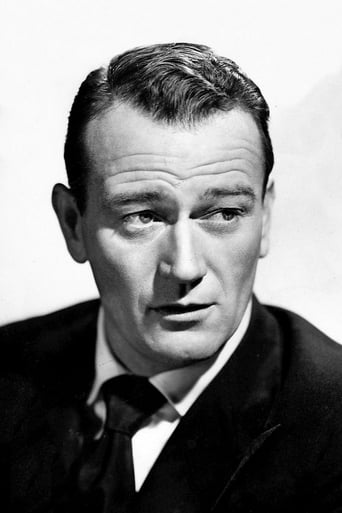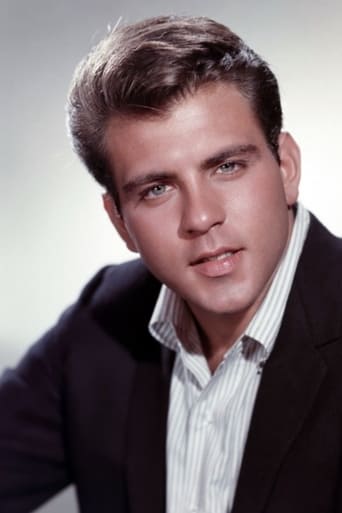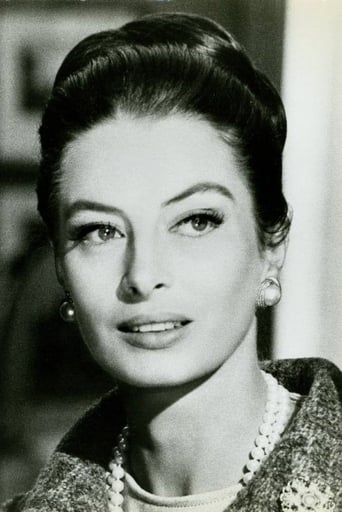vkorchnoifan
Its been 58 years years when I first saw this delightful movie. All of the actors and actresses play their part. Excellent production, straight forward direction, and good writing made this movie a memorable and enjoyable one. Only Fabian is left to enjoy the memory of this production. I wonder what he is doing ?
john_vance-20806
I saw this as a kid and was thoroughly entertained. On re-viewing it 40+ years later I liked it even better.John Wayne plays his usual rollicking tough-guy-with-a-heart-of-gold role. The man may have not had much acting depth, but within his element he could project an image and deliver a line as well as anyone in the business. I'm sure purists roll their eyes at his lasting fame, but if you want movies that entertain adults as well as the kids you rarely find a dud in the John Wayne collection.One might presume that Stewart Granger was perhaps too good an actor for this film but he fits right in. He certainly played the part well as would be expected but he seemed to have a great time.Cappucine. Well, what can you say but hubba hubba. Well, you can also say the woman had some solid chops. She had legitimate comedic skills and though her roles were limited she made the best out of them. Her death by suicide, evidently related to some kind of depressive or bipolar disorder, was simply sad. One has to wonder if with the tools of today it might have been avoidable.Fabian? Wow, that guy could really grow hair. But in all fairness he wasn't bad at all. He knew his limits and kept well within them. As a result he could contribute meaningfully to a film and not just as eye candy for the teenyboppers.The film is dated of course. Comedy of this style hasn't sold well since the Newman-Redford productions of the 70s. But for those of us old enough to remember the era this is a worthwhile sit-down.
JohnHowardReid
Producer: Henry Hathaway. Copyright 1960 by 20th Century-Fox Film Corp. New York opening at the Paramount: 10 November 1960. U.S. release: 7 November 1960. U.K. release: 1 January 1961. Australian release: 19 January 1961. 10,967 feet. 122 minutes.SYNOPSIS: In the Alaska of 1900 three gold prospectors, Sam McCord, his partner George Pratt, and George's kid brother Billy, strike it rich. With his new wealth, George can now marry his Seattle fiancée of three years standing and Sam agrees to go and fetch her while George builds a honeymoon cottage. But once in Seattle Sam learns that George's French fiancée got tired of waiting and married someone else. Reluctant to disappoint his friend, Sam invites another French girl, a honky-tonk entertainer named Michelle, to accompany him back to the gold mine. Thinking he intends her for himself, the girl accepts.NOTES: Fox's most successful film at the U.S./Canadian box-office for 1960-61. Initial domestic rentals gross: around $4.8 million. Number 12 at the Australian box-office for 1961.COMMENT: Besides being one of the most entertaining films to issue from Hollywood during the year, "North to Alaska" is a wonderful example of professional film-making at its finest. Uniting the first-rate writing talents of John Lee Mahin, Martin Rackin and Claude Binyon, the screenplay is a thoroughly enjoyable burlesque of such standard clichés of Yukon folklore as the old prospector who strikes it rich, the flat-broke gambler with a heart of gold, the young greenhorn courting fame, riches, and fair lady — a heroine purer than the driven snow. These familiar elements are deftly transformed into John Wayne's virile prospector, Ernie Kovac's nervous card-sharp, Fabian's unwillingly protected innocent, Capucine's graceful prostitute. These characters are involved in a story that is both witty and diverting, set against a background designed to provide the director with the maximum opportunity for scenic effect.Certainly no director could have realized the scenario in a more capable fashion than Henry Hathaway has done. And as he was also producing, he was able to hire hundreds of extras (and a competent 2nd unit director, Richard Talmadge, to help him handle them) and fill the magnificent sets created by Duncan Cramer and Jack Martin Smith with a wealth of authentic detail. Atmosphere is also provided by Lionel Newman's rousing score. The film has no less than three glorious brawls, two of which are amusingly punctuated by inappropriate music — the carefree strains of a nickelodeon and the hymnal cacophony of a Salvation Army band.Whether capturing the swirling cerise rapids of the conifer and white Alaskan wilderness or the deep forest greenery of former-day Seattle, whether lingering over the ocher shimmering of an Aurora Borealis or the teeming foreshores of Nome, Leon Shamroy's color photography is both smoothly proficient and aesthetically pleasing.Superbly edited by Dorothy Spencer, the film moves at a brisk, effervescent pace. There are a number of scenes — such as Fabian's attempt at seduction and Stewart Granger's false celebration — which in the hands of a lesser editor or a less talented director, could have become either embarrassing or verbose. Both these pit-falls have been skilfully avoided, and despite the slightly sordid nature of the subject matter, Hathaway has treated it with such a high degree of intelligence and sophistication as to render any charge of vulgarity ineffectual.Acting is of an unusually meritorious standard throughout. The principals are excellent, with Mickey Shaughnessy and Stanley Adams taking honors in supporting slots. It was also pleasing to see Joe Sawyer, in a minor role as the Commissioner, looking as hale and hearty as ever."North to Alaska" is the very epitome of all that is best in Hathaway films: A robust, vigorous, manly quality, combined with a gifted deployment of location backgrounds, an inventive use of camera angles, and the highly accomplished management of action.
Tweekums
When partners Sam McCord and George Pratt strike it rich in Alaska Sam heads down to Seattle to bring back George's French fiancée... there is a problem though; she has married somebody else! Sam comes up with a solution though; he'll take back another French girl instead; prostitute Michelle 'Angel' Bonet. His intention is that George will be just as pleased with Michelle; Michelle misunderstands though and thinks Sam wants her himself; understandably she is a little put out when she discovers the truth. When they reach Alaska they find out that George it no longer in town; he had to head up to the mine with his younger brother Billy. Needless to say things don't go as Sam expected; Billy falls in love with Michelle and when he finally gets George to meet her he isn't happy about being sent a 'replacement'... the biggest surprise for confirmed bachelor Sam is that he falls for her... but thinks she is with George!! If all that romantic confusion wasn't enough conman Frankie Canon keeps trying to swindle them; first out of a few hundred dollars then out of the mine.I thought I might not enjoy this after an early barroom brawl was full of over the top slapstick and comedy sound effects one would expect in a Loony Tunes cartoon. I soon found myself enjoying it however as it got more sensible; and funnier after that. John Wayne did a good job as Sam; playing him fairly straight rather than going for cheap laughs. French actress Capucine was a delight as Michelle; one can see why the men in the film took a shine to her! The rest of the cast were pretty good too. The 'Alaskan' scenery looks good even if it is really California. One might think that having a prostitute as a main character would make this unsuitable for children but what she does isn't spelt so youngsters are likely to think that she is just a dancer, the action scenes are child friendly too with slapstick brawls and no fatalities despite there being a shootout. At two hours this is a little on the long side but not excessively so. Overall I'd say this is worth watching if you like John Wayne westerns and want a chuckle.





